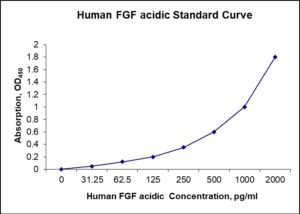Nori Human FGF Acidic ELISA Kit
$461.00 – $832.00
This ELISA kit is for quantification of FGFa in human. This is a quick ELISA assay that reduces time to 50% compared to the conventional method, and the entire assay only takes 3 hours. This assay employs the quantitative sandwich enzyme immunoassay technique and uses biotin-streptavidin chemistry to improve the performance of the assays. An antibody specific for FGFa has been pre-coated onto a microplate. Standards and samples are pipetted into the wells and any FGFa present is bound by the immobilized antibody. After washing away any unbound substances, a detection antibody specific for FGFa is added to the wells. Following wash to remove any unbound antibody reagent, a detection reagent is added. After intensive wash a substrate solution is added to the wells and color develops in proportion to the amount of FGFa bound in the initial step. The color development is stopped, and the intensity of the color is measured.
Alternative names for FGFa: acidic fibroblast growth factor, FGF-1, ECGF, HBGF1
This product is for laboratory research use only not for diagnostic and therapeutic purposes or any other purposes.
- Description
- How Elisa Works
- Product Citation (25)
- Reviews (0)
Description
Nori Human FGF Acidic ELISA Kit Summary
Alternative names for FGF acidic: acidic fibroblast growth factor, FGF-1, ECGF, HBGF1, FGFA
| Assay Type | Solid Phase Sandwich ELISA |
| Format | 96-well Microplate or 96-Well Strip Microplate |
| Method of Detection | Colorimetric |
| Number of Targets Detected | 1 |
| Target Antigen Accession Number | P05230 |
| Assay Length | 3 hours |
| Quantitative/Semiquantitative | Quantitative |
| Sample Type | Plasma, Serum, Cell Culture, Urine, Cell/Tissue Lysates, Synovial Fluid, BAL, |
| Recommended Sample Dilution (Plasma/Serum) | No dilution for sample <ULOQ; sufficient dilution for samples >ULOQ |
| Sensitivity | 6 pg/mL |
| Detection Range | 31.25-2000 pg/mL |
| Specificity | Human FGFA |
| Cross-Reactivity | < 0.5% cross-reactivity observed with available related molecules, < 50% cross-species reactivity observed with species tested. |
| Interference | No significant interference observed with available related molecules |
| Storage/Stability | 4 ºC for up to 6 months |
| Usage | For Laboratory Research Use Only. Not for diagnostic or therapeutic use. |
| Additional Notes | The kit allows for use in multiple experiments. |
Standard Curve
Kit Components
1. Pre-coated 96-well Microplate
2. Biotinylated Detection Antibody
3. Streptavidin-HRP Conjugate
4. Lyophilized Standards
5. TMB One-Step Substrate
6. Stop Solution
7. 20 x PBS
8. Assay Buffer
Other Materials Required but not Provided:
1. Microplate Reader capable of measuring absorption at 450 nm
2. Log-log graph paper or computer and software for ELISA data analysis
3. Precision pipettes (1-1000 µl)
4. Multi-channel pipettes (300 µl)
5. Distilled or deionized water
Protocol Outline
1. Prepare all reagents, samples and standards as instructed in the datasheet.
2. Add 100 µl of Standard or samples to each well and incubate 1 h at RT.
3. Add 100 µl of Working Detection Antibody to each well and incubate 1 h at RT.
4. Add 100 µl of Working Streptavidin-HRP to each well and incubate 20 min at RT.
5. Add 100 µl of Substrate to each well and incubate 5-30 min at RT.
6. Add 50 µl of Stop Solution to each well and read at 450 nm immediately.
Background:
Acidic fibroblast growth factor known as FGF acidic, also known as FGF-1, ECGF, and HBGF-1, is a mitogenic peptide that is produced by multiple cell types and stimulates the proliferation of cells of mesodermal, ectodermal, and endodermal origin. FGF acidic is involved in wound repair, angiogenesis, and development. FGF acidic is secreted from cells via an endoplasmic reticulum/Golgi independent mechanism (1, 2). The ability of FGF acidic to bind to heparin sulfate is required for its ability to interact with FGF receptors and induce signaling (1-4). There are four distinct FGF receptors and each has multiple splice variants. FGF acidic binds with high affinity to many, but not all, FGFRs. Signaling cascades activated through FGF basic binding to FGFR include the ras-raf-MAPK, PLCγ/PKC, and PI3K/Akt pathways.
References
- Prudovsky, I. et al. (2003) J Cell Sci 116, 4871.
- Powers, C.J. et al. (2000) Endocr Relat Cancer 7, 165.
- Mohammadi, M. et al. (2005) Curr Opin Struct Biol 15, 506.
- Ornitz, D.M. and Itoh, N. (2001) Genome Biol 2, REVIEWS3005.
Be the first to review “Nori Human FGF Acidic ELISA Kit”
You must be logged in to post a review.




























Reviews
There are no reviews yet.